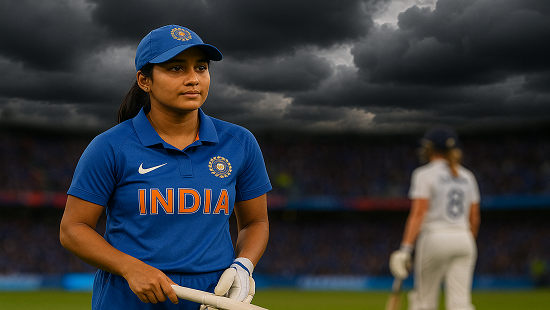
Clouds Over Glory: Will Rain Steal India’s Shot at the Women’s World Cup Final?
In Navi Mumbai, the anticipation is electric. The DY Patil Stadium, draped in blue and gold, stands ready to host one of the most anticipated matches of the ICC Women’s World Cup 2025, India versus Australia. Yet, amid the excitement, an unwelcome player threatens to take the spotlight: the weather.
After South Africa’s commanding 100-run victory over England in Guwahati secured their maiden entry into the Women’s World Cup final, all eyes now turn to Mumbai’s coastline, where the second semi-final promises both cricketing brilliance and meteorological drama.
The stakes are monumental. A victory for Harmanpreet Kaur’s India would not only mean a shot at the title but also a symbolic statement, that women’s cricket in India has arrived at par with the world’s best. But between India and their dream stands a familiar powerhouse: the Australian women, led by the seasoned Alyssa Healy. And perhaps, more unpredictably, the monsoon’s lingering touch.
Weather Forecast: Mumbai’s Uncertain Sky
For days, the weather in Navi Mumbai has teased fans with alternating bursts of sunlight and sudden showers. Meteorological forecasts for Thursday, October 30, predict light morning rain and heavy cloud cover for most of the day. Although conditions are expected to improve by afternoon, intermittent drizzle could still disrupt the rhythm of play.
AccuWeather data shows temperatures ranging between 25°C and 32°C, with humidity hovering around 60 percent, a classic coastal mix that encourages early seam movement before easing into a batting-friendly track under lights. The DY Patil surface, known for its bounce and fast outfield, rewards stroke-makers, but even short rain interruptions could change the contest’s momentum.
For India, whose batting thrives on rhythm and flow, any weather-induced pause could prove tricky. Conversely, Australia’s disciplined bowling attack, adept at exploiting conditions, might find early advantage if the skies stay overcast.
Lessons from a Rain-Soaked Tournament
The Women’s World Cup 2025 has already seen weather emerge as a silent disruptor. Several fixtures, especially those hosted in Sri Lanka, ended prematurely due to heavy rain. In fact, India’s final league-stage match against New Zealand at this very venue was curtailed by showers, with both innings shortened and the DLS method deciding the outcome.
This recurring pattern has amplified concerns about scheduling in tropical zones during peak monsoon transition. While cricket thrives on unpredictability, frequent weather disruptions risk overshadowing athletic excellence. Yet, as experts point out, the real test of resilience lies not in conditions but in adaptability, something this Indian team has shown in abundance.
India’s Journey: Resilience and Reinvention
Led by the dynamic Harmanpreet Kaur, India’s campaign has been a blend of grit and grace. After a shaky start in the group stages, the team rallied through crucial wins built on collective performance, Smriti Mandhana’s aggressive starts, Shafali Verma’s fearless stroke play, and Renuka Thakur’s sharp swing spells.
But beyond individual brilliance lies a quiet transformation: this Indian side’s growing composure under pressure. They’ve embraced modern cricket’s data-driven discipline without losing their instinctive flair. Against an opponent like Australia, whose dominance stems from consistency and strategic precision, this mental strength could be India’s most potent weapon.
However, their challenge on Thursday extends beyond the pitch. “Rain delays test focus,” said a former Indian coach. “Momentum breaks, conditions shift, and strategies must reset within minutes.” For India, keeping their rhythm amid uncertainty will be crucial.
The Australian Threat
Australia, the defending champions, arrive with a mix of confidence and caution. They’ve dominated the group stages with typical efficiency, Alyssa Healy anchoring innings, Ellyse Perry controlling the middle overs, and Megan Schutt leading a versatile pace attack.
Yet, they’re not invincible. In recent months, Australia has shown occasional vulnerability under scoreboard pressure. India’s 2023 bilateral series win against them proved that when Indian bowlers hit their lengths and batters play fearless cricket, the gap between the two sides narrows significantly.
What sets this semi-final apart is the intangible weight of expectation. For India, it’s not just about beating Australia; it’s about reclaiming belief, a reminder of their near miss in the 2017 final and their heartbreak in 2020.
The Rain Equation: What Happens if It Pours?
The ICC has ensured that weather does not dictate the outcome without a fight. Each knockout match, including this semi-final, carries a designated reserve day. If heavy showers prevent play on October 30, the game will resume on October 31.
But if conditions remain unplayable even then, the rules turn cruelly pragmatic: the higher-ranked team from the group stage advances automatically. That means Australia, who finished above India on the points table, would proceed to the final without a ball being bowled.
For fans, that possibility is unbearable, a dream undone not by defeat, but by drizzle. “It’s heartbreaking to imagine,” says Meera S., a local cricket enthusiast waiting outside DY Patil Stadium. “After months of preparation, passion, and pride, to lose to weather feels unfair. But that’s cricket.”
Why This Match Matters Beyond the Scoreboard
Regardless of the weather, this semi-final marks a watershed moment for women’s cricket in India. The game’s visibility, fan engagement, and broadcast reach have reached unprecedented levels. Ticket sales in Mumbai sold out within hours, and online search trends for the match rivalled those of men’s fixtures.
The narrative has shifted from curiosity to conviction, these athletes are no longer just symbols of representation but pillars of performance. As India’s women chase sporting history, the nation watches not out of novelty, but belief.
Charting the Future of Women’s Cricket
Whatever the outcome, the India-Australia semi-final will stand as a metaphor for the sport’s evolution, where professionalism meets passion, and data meets destiny. It reflects how far women’s cricket has come in both scale and substance.
As the clouds hover over Navi Mumbai, the city holds its breath. Rain or shine, the Indian women’s team has already redefined what it means to compete, not merely to participate, but to inspire. Whether the thunder on Thursday comes from the sky or the bat, one thing is certain: this is not just another match. It’s a moment where ambition, adversity, and atmosphere collide on the grandest stage.





